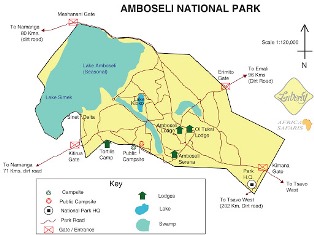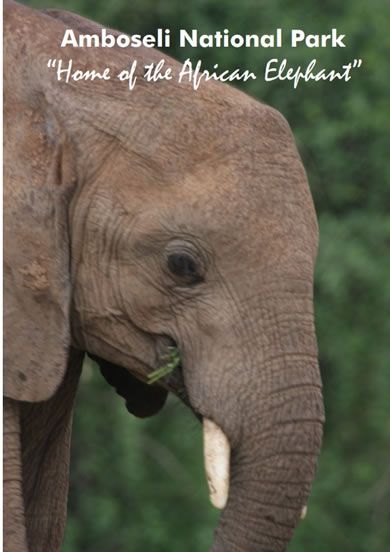Amboseli National Park
Home of the African Elephant
Fact File: Amboseli National Park
The Amboseli ecosystem covers an area of approximately 5,700 km2 stretching between Mt. Kilimanjaro, Chyulu Hills, Tsavo West National Park, and the Kenya-Tanzania border.
Administratively, the ecosystem consists of Amboseli National Park and six surrounding group ranches: Kimana/Tikondo, Olgulului/Olararashi, Selengei, Mbirikani, Kuku, and Rombo. The Amboseli ecosystem is rich in biodiversity, earning it international recognition as a UNESCO Biosphere Reserve.
Amboseli National Park
Overview
On the broad, flat plains south of Nairobi, Amboseli is Kenya’s elephant park par excellence. One of the oldest national parks in Kenya, originally part of the
colonial era’s ‘Southern Maasai Reserve’, Amboseli became a wildlife sanctuary in the 1940s and the Maasai were evicted. However, the swamps here were used by the local communities to water their herds, and first the area’s magnificent, long- horned black rhinos, and then most of the lions were wiped out as the excluded herders retaliated. Amboseli has been a high-profile bellwether for human-wildlife relations in Kenya ever since.
The lions are back in the relatively small park (just 400km²), and any doubts about it are totally allayed by its magnificent elephant herds and high counts of other plains wildlife. The animals are attracted to the park’s strikingly beautiful, perennial swamps, and can often be seen against the irresistible backdrop of Kilimanjaro, towering behind. Amboseli has a wildebeest and zebra migration, like the Maasai Mara’s but on a much smaller scale, but thousands of animals are resident here all year round.
Amboseli has excellent accommodation facilities like in the 40km² Elerai Conservation Area, just east of the park itself, Satao Elerai Camp, is a very well-run, comfortable set-up with great views of Kili (it’s the closest Kenyan lodge to the mountain) and a welcome swimming pool. Game drives are conducted in the conservation area, which is exclusive to Satao, as well as in Amboseli National Park itself. Located between Amboseli National Park and the exclusive 120km² Kitirua Conservancy, Tortilis Camp is named after the flat-topped Acacia tortilis umbrellathorn tree, common to the area. Set on a low hill around a waterhole, with excellent views of Kilimanjaro (when the mountain is showing itself), Tortilis Camp has 18 thatch-roofed tents,
Selenkay (Selengei) Conservancy
North of Amboseli proper, the Selenkay Conservancy offers promise where the total- exclusion model of the national parks sometimes seems to be mired in conflict. Jake Grieves-Cook (later head of the Kenya Tourist Board and founder of the Porini Camps) visited this area as a young man in the 1970s when it was teeming with wildlife. Returning in the 1990s, he found the wildlife decimated, elephants absent and the environment degraded by livestock over- grazing. He met the Maasai elders and discussed setting up a wildlife conservancy on their land to create a protected habitat to bring back the wildlife and generate an income for the community. The Selenkay Conservancy was the result and a wide variety of wildlife now live there, including elephants that had not been seen for 20 years.
Animals & Bio-Diversity
Over 53 species of herbivores and carnivores can be viewed with ease, the most conspicuous being the troops of over one thousand elephants who range the plains and wallow the swamps. A number of other unique animals also populate the area including lion, cheetah, giraffes, zebras, buffalo, rhino, wildebeest, gerenuks, impalas, gazelles, hyenas, baboons, bats and about 425 different species of birds. The Amboseli ecosystem is typical of the open avannah grassland habitats of Eastern Africa, featuring open wooded grasslands, rolling hills and swamplands whilst the presence of Mount Kilimanjaro creates a unique selection of ecosystems found nowhere else on earth. The Amboseli basin is fed by springs that provide a permanent source of water during the dry season, while the river systems north of the basin form a seasonal flood plain that is used by migratory animals during the rainy easons. Although the region has a relatively low wildlife biomass it supports a greater variety of animals than neighboring Tsavo which is fifty times bigger than the compact but comprehensive Amboseli.
The Amboseli Safari Experience
“Home of the African Elephant”
Crowned by Mount Kilimanjaro, Africa's highest peak, the Amboseli National Parks is one of Kenya's most popular parks. The name "Amboseli" comes from a Maasai word meaning "salty dust", and it is one of the best places in Africa to view large herds of elephants up close. Nature lovers can explore five different habitats here ranging from the dried-up bed of Lake Amboseli, wetlands with sulphur springs, the savannah and woodlands. They can also visit the local Maasai community who live around the park and experience their authentic culture.
Attractions
- Large Herds of Elephants
- Mt. Kilimanjaro
- Predators and large mammals
- Observation Hill which allows an overall view of the whole park especially the swamps and elephants, Swamp below observation hill hosts many elephants, buffaloes, hippos and a variety of water fowls like pelican, Egyptian goose Contemporary Maasai culture and indigenous lifestyleWildlife:
Animal Checklist:
Leopard, Cheetah, Wild dogs, Buffalo, Elephant, Giraffe, Zebra, Lion, Crocodile, Mongoose, Hyrax, Dik- dik, Lesser Kudu, and Nocturnal Porcupine
Bird Life:
Prolific birdlife features 540 species




